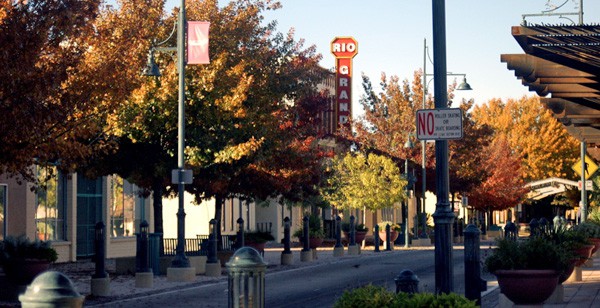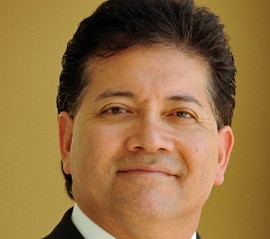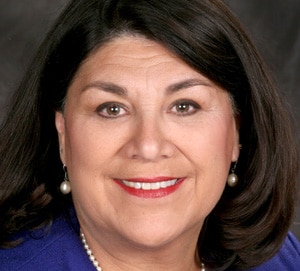
A section of Main Street in downtown Las Cruces that has gone through revitalization. (Courtesy photo)
Here’s what Las Cruces’ mayoral candidates have to say about quality-of-life and sustainability issues, including curbside recycling, red-light cameras, and what the city should do to ensure it has enough water going forward
Las Cruces Mayor Ken Miyagishima has a lot to say about the city’s accomplishments over the last four years in terms of quality of life and sustainability.
He cites curbside recycling, the new aquatic center, downtown revitalization, and four new parks as some of the city’s accomplishments.
“Ensuring a good quality of life for residents is a key task of city government,” Miyagishima said. “It has been a goal of the current council to create a vibrant public space in which everyone can participate, as we continue to build a community that all can enjoy.”
Challenger Michael Ray Huerta says he supports the curbside recycling program and the efforts by the city in recent years to build bike lanes and paths. And he says he’s about to announce a financial initiative that will bring new revenue to the city that can be used to improve quality of life. He wouldn’t discuss details, but he made a massive promise – $40 million to $45 million in new revenue for the city.
“With this bold but necessary step, we can improve the maintenance of existing parks, work to purchase the Las Cruces Country Club, dedicate funds for non-profit innovation and expansion, strengthen our first-time home buyers program, lead on a 21st Century, city lead after-school program, all while reducing the size of our local government,” Huerta said.
District 2 Councilor Dolores Connor, Miyagishima’s other challenger in the Nov. 8 election, takes a different approach, saying the city needs to get back to the basics – public safety. She wants to focus on developing the new 911 dispatch and public safety facility and says the city is short four fire stations.
“These are priorities that I will have as mayor – ensuring the safety of our citizens is moved to the forefront,” Connor said.
At the same time, Connor says the current council has pushed some important quality-of-life projects to the back burner, such as relocation of the Museum of Nature and Science.
NMPolitics.net also asked the three candidates about the city’s efforts to ensure it has enough water in the future, and about a hot topic in Las Cruces, red-light cameras. Connor said the city’s purchasing of surface water rights “is an important mechanism to help with ensuring we have the water available for four future needs.” Miyagishima agreed. Huerta didn’t answer questions about water.
But Huerta did say he opposes red-light cameras. Connor and Miyagishima, who supported the cameras’ implementation two years ago, are taking a wait-and-see approach to the cameras’ future. Miyagishima said his continued support “depends on an evaluation of data that is being accumulated as to their effectiveness in increasing traffic safety.” Connor said she requested the New Mexico State University review of the data. She also said she supports asking voters whether they want to keep the cameras, as the City of Albuquerque recently did (in a nonbinding vote, voters rejected the cameras).
The questions
The candidates were responding to questions NMPolitics.net asked about quality of life and sustainability. Here are the questions:
“The city has made an intentional effort in the last few years to focus on quality of life and sustainability. What would you do as mayor to ensure that the city is planning for its future? Please identify specific initiatives or proposals you want to implement in the next four years.
“What specific measures would you support to ensure the city has enough water in the future? Do you support the city’s strategy of purchasing surface water rights? Why or why not?
“Do you support the new curbside recycling program? Do you support turning driving lanes on city streets into bike paths, as was done on Solano? In these economic times, should the city be spending money on adding parks and bike and walking trails, as it has done during the last four years? Should the city buy the old Las Cruces Country Club to turn it into a park? Do you support the use of red-light cameras? On all of these questions, why or why not?”
Here are the candidates’ full responses:

Las Cruces mayoral candidate Michael Ray Huerta
Michael Ray Huerta
“In the coming days, my campaign will be announcing the details of a financial proposal to bring in $40-45 million in revenue for the city. These new funds can be used to improve the quality of life for not only our new residents, but those long-time Las Crucens who have not seen their neighborhoods improve over the past 4 and 8 years. With this bold but necessary step, we can improve the maintenance of existing parks, work to purchase the Las Cruces Country Club, dedicate funds for non-profit innovation and expansion, strengthen our first-time homebuyers program, lead on a 21st Century city-led after-school program, all while reducing the size of our local government. When the plan is announced, I look forward to much debate on its potential to move our city forward during these difficult economic times. More than anything, I’m proud to be the candidate of ideas and innovation.
“I do support the new curbside recycling program, as well as increasing the ability for bicyclists to get around our city – and not just for recreational purposes. Before we move on new projects, however, initial costs must be accounted for, as well as future maintenance considerations.
“Regarding red-light cameras, there is a clear difference between my opponents and me. While Councilor Connor sponsored the initial resolution putting them in place, and Mayor Miyagishima voted to support their implementation, I am strongly opposed to them. They don’t work, they send local money to a foreign corporation, and they cause clear violations of due process.
“According to the city’s own studies, at every intersection where we have them, we’ve seen an increase in the number of accidents by an average of 14%. Why? Las Crucens, worried about receiving one of these ridiculous citations, slam on their brakes at a yellow light while other drivers follow New Mexico driving guidelines and attempt to drive through the intersection. The result? A documented increase in accidents. They clearly don’t work, and we don’t need to wait for another study.
“Additionally, when my opponents voted to bring in red-light cameras, they actually voted to allow a foreign corporation to implement and run the program. What does that mean? Every time a Las Crucen receives a citation, 50% of their fee goes straight to Australia. That is wrong.
“Finally, Las Crucens have no opportunity to appeal these citations in a court of law, as they would any other citation. Instead, one can only be heard in front of an ‘independent hearing officer’ who is a political appointee, appointed by the mayor. And in our town’s good ol’ boys system, we know how well that is going to work out for the average Las Crucen.
“I’ve never received one of these citations, and neither have the vast majority of Las Crucens. But for the sake of all of us who are against increased accidents, sending local money overseas, and violations of due process, we must get rid of red-light cameras.”

Las Cruces Mayor Ken Miyagishima
Ken Miyagishima
“Ensuring a good quality of life for residents is a key task of city government. It has been a goal of the current council to create a vibrant public space in which everyone can participate, as we continue to build a community that all can enjoy.
“Among the improvements in quality of life in the past four years have been curbside recycling, the new Aquatic Center and a rapidly revitalizing downtown, anchored by the new City Hall and Convention Center. We have added 77 acres of park land and 4 new parks, including the Las Cruces Dog Park. Our Farmer’s Market was voted the #1 large market in the United States. We have worked hard to develop our adult and youth recreation programs, including partnering with NMSU for sports camps and cheer programs, and instituting a waiver program for youth league fees, so all children can participate.
“Over the next four years we will continue to build on these achievements, with a special emphasis on maintaining and enhancing existing neighborhoods, and continuing to build neighborhood connectivity through walk paths, bike paths and trails. We hope to encourage planning that will help make sure more shopping, schools and recreational opportunities are within walking distance of residents’ homes.
“Water continues to be an increasingly valuable commodity for any growing city, not only for our current residents, but future residents as well. Here at the city of Las Cruces we are ensuring the city has enough water in the future by implementing the following programs:
“1. Purchasing additional water rights when they become available.
“2. Expanding the use of ‘reclaimed’ water. The city of Las Cruces has a new state-of-the-art water reclamation plant located east of our city’s limits. It is designed to save over 1,000,000 gallons of fresh drinking water every day.
“3. The city also has a very aggressive water conservation program that has allowed us to reduce our water consumption by over 15% since 2004. We have accomplished this even though our population has increased by over 17,000 residents.
“I support the city’s strategy of purchasing surface water rights to provide security for future consumption and growth. We are extremely fortunate that our water rights have been adjudicated with a senior right of 1906-1907. This allows the city of Las Cruces to have some of the most senior water rights in the Mesilla Valley, with only NMSU having the top water rights of 1870. We must continue to purchase surface water rights so that our successors and future residents have water well into the next century and beyond.
“In terms of specific quality of life improvements, I – like most Las Crucens – love the new curbside recycling program. Most of us are finding that our recycling bin fills up a lot faster than our garbage bin, which is good for the environment, but also good from a financial standpoint, since we won’t need to acquire as much land for solid waste disposal. Curbside recycling has been a real success for the city.
“I also strongly support having our neighborhoods linked by a variety of transportation options, including walking and bike paths. This fits in well with our Safe Routes to School program, and with the kind of recreational opportunities and connectivity that residents prefer. The Las Cruces Loop Trail will anchor a regional network of bike and walking paths, a network that will benefit from our recent agreement with Elephant Butte Irrigation District to use ditch banks part of that system.
“None of this has cost a great deal of money, and it fits within our budgetary priorities. We see this as a continuing investment in our city, one that makes Las Cruces a place where both new and longtime residents want to live.
“It has also been proposed that the City buy the old Las Cruces Country Club and turn it into a park. I share with most Las Crucens an excitement about the opportunity to create a large, tree-lined park near the center of the city. At the present time that land remains in private hands, and the current owners have not decided what they want to do with the property. We will, however, continue to monitor discussions about its future, with the hope of presenting city residents with a variety of options for possible acquisition and use.
“On the question of red-light cameras, their future depends on an evaluation of data that is being accumulated as to their effectiveness in increasing traffic safety. Red-light cameras are used across the country to reduce serious accidents, and we will soon be able to evaluate their effectiveness here.”

Las Cruces mayoral candidate Dolores Connor
Dolores Connor
“It is important to get back to the basics of what a city should be providing, and that is public safety. Developing the MVRDA 911/Public Safety Campus is a critical investment for our community. The ISO report shows that we are 4 fire stations short of what a community our size should have. These are priorities that I will have as Mayor – ensuring the safety of our citizens is moved to the forefront.
“There are important quality of life projects that this current council’s leadership has pushed to the back because of their agenda. We have funding available to build an intermodal transportation facility in the downtown area that would be an added improvement to our public transportation system. This is money that we secured in 2001 through federal transportation funding. The project has been studied, designed and yet 10 years later we have not started construction.
“Another project that is important for our young people is the relocation of City Service Center/Offices on Hadley Ave. This project goes back to 1988 when the land was purchased on Motel Blvd for the relocation and would open up space near existing recreational areas on Hadley Avenue that can be reused for additional ball fields/soccer fields for our kids.
“And of course, we all have known of the Museum of Nature and Science that is housed at the mall, in which we pay $70K a year in rent. Yet in 2006 we purchased a building downtown next to our museum system for the relocation. This project also has money in the bank from grants that have been awarded for the museum, but a lack of focus on the project has kept it from moving forward quicker.
“It is important to continue to work with our city Utilities director on monitoring the water resource needs of our city. Strategies like the purchasing of surface water rights is an important mechanism to help with ensuring we have the water available for our future needs, which is why I would continue to support this item. I think it is also important to work with our water partners in our region to ensure that our water needs of our region are met. These partners would include Elephant Butte Irrigation District (EBID) so that issues are met head on and collaborative solutions can be developed.
“I would also champion the water-saving measures that are promoted through our water conservation program. Completing projects like the El Molino Flood Control project will provide an opportunity to collect and park water, allowing that water to recharge our existing aquifer. These are innovative methods to address future water needs.
“I am a supporter of recycling and my husband and I were consistent users of the recycling drop-off locations in the City. I felt that the curbside recycling program was a Cadillac approach, one that would charge all citizens for a service that not everyone would use. I was in favor of an approach that would test the service first (without the additional charge, since the citizens of Las Cruces were already paying a $3.03 recycling fee) to determine the viability of the curbside service. Adding an additional fee of $2.59 in addition to what was being collected was not a fair option to all citizens. Also a note to consider is if less trash is going to the landfill wouldn’t there be a reduction of cost for the service?
“Bike paths are an interesting subject and one that is an indication of where current council leadership has gotten off course. I support new development incorporating bike paths into their design. Retrofitting existing streets to accommodate bike paths at the cost of other needed services is not what I support. Doing so, without any public meetings, simply shows the lack of transparency by city council. When the initial phase of Solano was transformed into bike paths, it was done with no public meetings, especially with all the business owners along this highly commercial, highly trafficked street. Other options for bike paths were available on less trafficked north/south roads. When the second phase of Solano was proposed, I ensured that public meetings were held with the property owners in my district, which is a residential portion of Solano adjacent to the University. The Triviz conversion also proved to be a disaster. With more accidents taking place, the road was redone a third time to its original use. There should be more scrutiny of funding for future proposed conversions to bike lanes.
“I would have the same philosophy on walking trails. I grew up in this town and during those times we did not need walking trails to chart a path for us. If we wanted to walk in the desert or along the irrigation ditches, we just did it. I cannot support city funding for walking trails when we do not have sufficient fields for our kids to play on. I will work to reuse the existing City office/service center on Hadley Avenue for fields for our kids to use.
“As your question indicates, these are interesting and difficult economic times. We have seen a declining city budget and cuts have had to be implemented. So as Mayor, it would be irresponsible for me to look at a shrinking budget, one that hasn’t focused enough resources on the existing park systems we have, and support the acquisition of the Las Cruces Country Club. I understand those around the Country Club would like for the citizens of Las Cruces to pay for them to keep the open space near their homes. Unfortunately we do not have the excess funds to purchase the property, and even if the property were donated to the City, we do not have the estimated $1,000,000 yearly maintenance budget to sustain the property as a city park. The intersection of Main and Solano has heavy traffic use. Currently, the Country Club is not for sale, and before anything else takes place a rehab of the intersection should be completed to ensure safety on this roadway. Main Street is owned by NMDOT, and just a few weeks ago we had a presentation at Council about the proposed traffic changes. This should be the first step.
“It is public record that I voted for the implementation of the red light camera program. Now after two years of data I have requested that NMSU review this data and an analysis be performed so that City Council can review what the situation was before and now after the cameras were installed. My support was based on the idea that red light cameras helped to change behavior, and I would like to see the data on whether that has happened in the two years from its implementation. Rules were changed once the red-light cameras were implemented that required half of the City’s proceeds from tickets be sent to the State of N.M. Once that review of the first two years has been made, an intelligent recommendation for the red-light cameras’ future can be made. Albuquerque asked the citizens in a non-binding vote to keep or remove the cameras. The vote was 53.6% voted against the cameras. I would support this type of question to the public.”